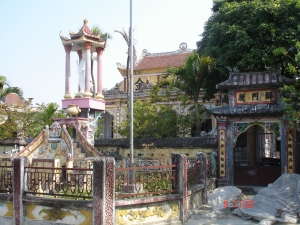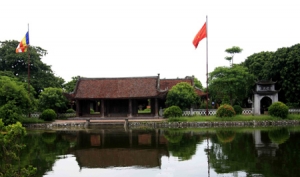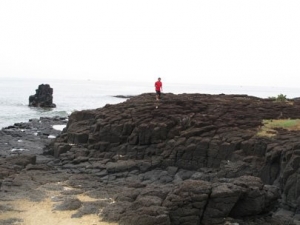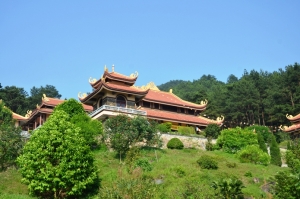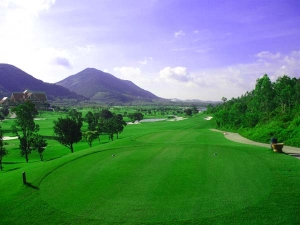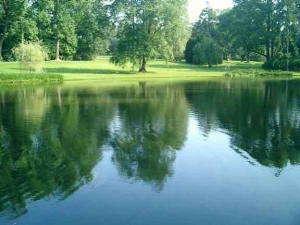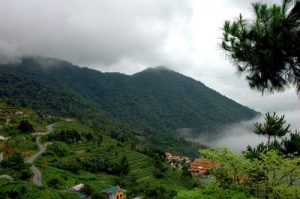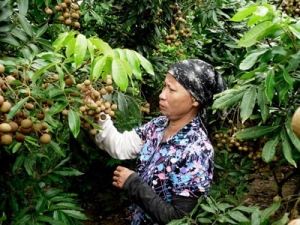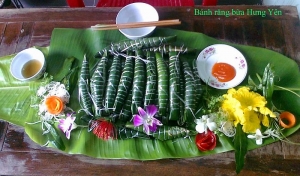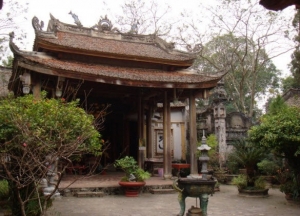
Asia Pacific Travel Team
Dong Xam Silver Village- One of the Most Well-Known Traditional Villages in Thai Binh
Located in Hong Thai Commune in the North of Kien Xuong District, Dong Xam Silver Village is widely famous for its silver processing which has existed since the 17th century. The fame of Dong Xam Silver is known not only in Vietnam, but also overseas. Silver handicrafts produced here are used in domestic market and exported to some foreign ones, such as Japan, South Korea, Taiwan, Laos, Thailand, Netherlands, and Spain.
Differently, Dong Xam’s silver products are characterized by strange styles of cube and appearance as well as sophisticated and well-proportioned decorations under delicate and perfect skill. Till now, the skill and carefulness of Dong Xam artists have been able to satisfy the tastes of using silver carving products of many customers who are difficult and knowledgeable about silver carving art. Dong Xam artists always think high of “faithfulness” and “talent”. Therefore, they try their best to make their own products which are always genuine and carefully-made to keep maintaining their customers’ confidence.
Dong Xam Temple
 Legend has it that 300 years ago, there was an artist named Nguyen Kim Lau, who had used his boat to travel downstream on Tra Ly River to earn his living. It was him who transferred his silver carving skills to local people in Dong Xuan village. Through the ups and downs, silver carving has been maintained and boomingly developed. After he died, Dong Xam Temple was built to appreciate his contributions to the village. Festival in the temple is yearly celebrated to mark the anniversary of the progenitor Kim Lau’s death.
Legend has it that 300 years ago, there was an artist named Nguyen Kim Lau, who had used his boat to travel downstream on Tra Ly River to earn his living. It was him who transferred his silver carving skills to local people in Dong Xuan village. Through the ups and downs, silver carving has been maintained and boomingly developed. After he died, Dong Xam Temple was built to appreciate his contributions to the village. Festival in the temple is yearly celebrated to mark the anniversary of the progenitor Kim Lau’s death.
Dong Xam Temple Festival
Dong Xam Temple Festival is annually held from 1st to 3rd day of the 4th lunar month. The most fascinating program in the festival is boat-racing contest on river with the participation of youth men in the hamlet and neighboring communes. Also, some interesting traditional games and folk culture like ca tru and cheo singing are performed during the festival. Significantly, a great deal of beautiful silver carving products is displayed in the days of the festival. Tourists in Vietnam travel have wide ranges to pick some of them as souvenirs for beloveds.
It is highly expected that Dong Xam Silver Village will make a positive contribution into the implementation of provincial socio-economic targets and help Thai Binh Province to gain rapid advances on the stage of industrialization and modernization. In near future, Dong Xam will promise to become one of the most interesting tourist attractions in Thai Binh Province, promoting to the development of Vietnam tourism in general and of provincial tourism in particular.
Keo Pagoda- A Pride for the Whole Vietnam
As far as130km from Hanoi capital, there located Keo Pagoda in Vu Thu District of Thai Binh Province. The pagoda is constructed by Duong Khong Lo, a Monk and famous doctor during Ly Dynasty.
History
Legend had it that Duong Khong Lo built Keo Pagoda between 1133 and 1154. Duong Khong Lo is a name of a Monk and famous doctor in Ly Dynasty. After successfully cured King Ly Thanh Tong from a serious disease, he was honorably given the title of Quoc Su (Royal Teacher) and plenty of money and land to build the pagoda.
Architecture
 Architecturally, Keo Pagoda is impressive to both domestic and foreign tourists inVietnam travel who have chance to visit the pagoda at least once time. The pagoda stretches the area of 7,200 square meters, bordering the Red River. There are two passages which separate the pagoda and temple. They are decorated with curved roofs that join together at the 11.5 meter-iron wood bell tower. This iron wood bell tower has three stories, each of which possesses its own tiled roof and bronze bell. Up to now, Keo Pagoda has proudly preserved one of the few surviving sets of rod puppets in Vietnam.
Architecturally, Keo Pagoda is impressive to both domestic and foreign tourists inVietnam travel who have chance to visit the pagoda at least once time. The pagoda stretches the area of 7,200 square meters, bordering the Red River. There are two passages which separate the pagoda and temple. They are decorated with curved roofs that join together at the 11.5 meter-iron wood bell tower. This iron wood bell tower has three stories, each of which possesses its own tiled roof and bronze bell. Up to now, Keo Pagoda has proudly preserved one of the few surviving sets of rod puppets in Vietnam.
It is said that Keo Pagoda is a home to a wealth of ancient relics which ranges from intricately engraved wooden dragons to a collection of over 100 statues. Here is also preserved many valuable antiques, such as a pair of candlesticks from the Mac Dynasty, some pottery ware and altars from the Le Dynasty, imperial boats, etc. It is surprising that all of them are kept intact as they were during the time of the Le Trung Hung Dynasty in 16th century.
Keo Temple Festival
The yearly festival is celebrated from 13th to 15th of the ninth lunar month, 100 days after the death of the Buddhist dignitary Duong Khong Lo. The festival features religious and traditional rituals and customs held in celebration of the Buddhist monk who rendered great merits to the people and the country. The festival also hosts different traditional cultural activities reflecting the life style, which is imbued with traits of the Red River Delta’s agricultural culture. Keo Temple Festival attracts hundreds of tourists in Vietnam travel every year.
The celebration
The pagoda’s own mythical appeal plays a significant role in drawing so many visitors to Vu Nhat Village each year on the 13th, 14th and 15th days of the ninth lunar month. Normally, people visit the commune to offer prayer at the Keo Pagoda in honor of the Buddhist monk. Similar to other Vietnam festivals and events, Keo Pagoda Festival commences with a procession of palanquin to remind people of the anniversary of Khong Lo’s death, followed by a boat race and a literary recital competition during the day. When night falls, it's time for music and a trumpet and drum competition, light from the main shrine illuminates preparations for the next day’s procession, prayers are offered until midnight.
 On the 14th day of the ninth lunar month, in celebration of the birth anniversary of monk Khong Lo, in the morning, the procession ceremony comes after the incense-offering ritual. A carriage pulled by two pairs of white and pink wooden horses head the procession, accompanied by 8 flag bearers and 42 men carrying bat but luu bo, a classical Vietnamese weapon. Four people wearing black gauze outfits and white trousers, who carry a dragon in commemoration of Khong Lo’s journey by boat to the capital of the kingdom to treat King Ly Nhan Tong. Four people in the same outfit carrying a small gilded boat put in a stand, depicting the period of monk Khong Lo’s life when he was a fisherman. In the afternoon, at Gia Roi shrine, the mua ech vo (frog-catching dance) ritual pays respect to the gods, while incense is offered to Buddha.
On the 14th day of the ninth lunar month, in celebration of the birth anniversary of monk Khong Lo, in the morning, the procession ceremony comes after the incense-offering ritual. A carriage pulled by two pairs of white and pink wooden horses head the procession, accompanied by 8 flag bearers and 42 men carrying bat but luu bo, a classical Vietnamese weapon. Four people wearing black gauze outfits and white trousers, who carry a dragon in commemoration of Khong Lo’s journey by boat to the capital of the kingdom to treat King Ly Nhan Tong. Four people in the same outfit carrying a small gilded boat put in a stand, depicting the period of monk Khong Lo’s life when he was a fisherman. In the afternoon, at Gia Roi shrine, the mua ech vo (frog-catching dance) ritual pays respect to the gods, while incense is offered to Buddha.
The festival continues into the next day with further entertainment and traditional games such as duck catching, rice cooking competition and firecracker hurling competition. However, the most interesting performance that attracts a large number of tourist is the boat rowing dance on land which is performed by 12 people in fine costumes, standing in two parallel lines like the way they sit in the boat. As one performer beats a small drum and another holds a wooden fish, the 12 performers "row" while flexing their legs and calling out rhythmically. This performance also puts an end to the three-day Keo Pagoda Festival.
It is believed that together with this meaningful festival, Keo Pagoda will remain a tourist- attractive destination in Vietnam and a pride for Vietnamese architects, Vu Nhat villagers and all of Thai Binh Province – as well as our whole country!
Travel to a picturesque spot in Quang Ngai province
"Thach Ky dieu tau" is a gorgeous spot located to the south of Sa Ky seaport in An Vinh Hamlet, Tinh Ky Commune in Son Tinh District in the province.
The picturesque site used to be among the top 12 landscapes of Quang Ngai province which was extolled by artists in the past but now is in the top two and is much loved by locals.
Nearby the cliff there are two huge human footsteps created from various stones and an open-air stone cave. When a wave flows into the cave, water will spray out from a hole beneath the cave that looks like a wine furnace. According to the legend, there was a giant man carrying stones to lock the seaport. But unfortunately, he dropped the last load of stones so it helped create two mountains and his footsteps were left behind.
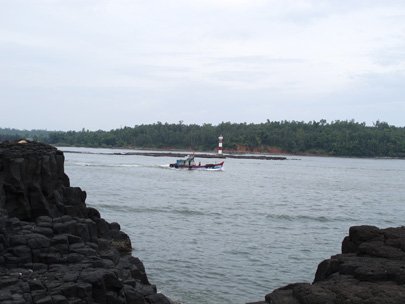
In particular, tourists will find it interesting to see a black lava block consisting of many diversified stone shapes spreading out the sea. According to scientists, thanks to the identity of these stones they can surmise that there was a volcano dated from tens of thousands years ago at this location.
As it has cliffs and holes there are many seafood specialties, among them are some tasty fish such as hong, doi, ke and hanh and huynh de crab, sea eel, sea snake and sea urchin.
Coming to the spot, tourists in Vietnam travel can admire the magnificent landscapes and watch daily activities of local people like children playing on waves and fishing coracles bubbling on the water surface.
Tay Thien Temple- birthplace of Vietnamese Buddhism
Tay Thien is located 600 meter-high mountain in Dai Dinh Commune, Tarn Duong District, Vinh Phuc province. It is dedicated to fairy Nang Thi Tieu. According to myth, she was one of the seven fairies Jade Emperor sent to the earth to treat diseases to save human beings. She married to Lang Lieu, the sixth Hung King and was conferred the title of Quoc Mau Tay Thien (Mother of the country), besides, religious structures, Tay Thien has beautiful landscapes with forests, waterfalls, streams.

Some of Tam Dao National Park’s famous sites such as: Thac Bac (The Silver Fall) and Rung Rinh peak – and finally reached the slopes of Thach Ban Mountain, one of the Tam Dao range’s three greatest peaks.
There sits Tay Thien, a well-known complex that is home to a cornucopia of historical Buddhist relics and temples. The complex boasts splendid architecture, rich history and breathtaking natural scenery.

Although the annual Tay Thien Spring Festival organised from the 15th-17th of the second lunar month each year – has yet to come, the pagodas and temples here were still numerous visitors.
There is now a cable car station at the mountain foot, next to Cau Temple. The ride just opened last month and gave us a wonderful view of the mountain surrounded forests, thick, lush and dense with vegetation and life.

Cable car in Tay Thien
Tay Thien is considered to be the birthplace of Vietnamese Buddhism. A Buddhist monk from India came here in the 3rd century BC chose this mountain as the spot from which to propagate the religion.
We saw several temples, many of which have been mostly lost to time, and others that have been fairly well preserved or restored.
Another attractive site in Tay Thien is the Truc Lam Tay Thien Zen Monastery, which together with a Zen Monastery in Da Lat and one at Quang Ninh Provinces’s Yen Tu Mountain, is one of the three largest monasteries in Vietnam.
Built in 2005 on the ruins of an ancient pagoda called Thien An Thien Tu, the Truc Lam Tay Thien Zen Monastery sits on the mountain’s peak and offers a stunning view of several other temples and pagodas scattered along the pine-decorated hills.
The site itself is at once tranquil and grandiose. The courtyards are very spacious and the buildings tall and striking. The monastery is decorated with ornate carvings on its doors and embossed works on its walls, ceilings, and pillars.
The monastery includes a library, a museum, a meditation house, guesthouses and a mess hall serving vegetarian food for visitors.
The Truc Lam Tay Thien Zen Monastery has become an increasingly popular training center for young students each summer. Here spend those months essentially living like monks: they eat vegetarian, wear monks’ robes and give up a lot of their “worldly” possessions.
Spectacular scenery of Tam Dao golf course
A new breed of warm climate grasses have been used to provide the golfer with perfect playing conditions all the year around.

If you are looking for a highly challenging golf course, displaying simply‘ Spectacular Views’, combined with High Class International Standards, then Tam Dao Golf Resort is for you. Built by IMG, the course beautifully winds itself through the natural terrain of the National Park lowlands. The golf course uses modern grass types, with the fairways being constructed from Salam Paspalum, and the generous undulating sizes greens using Sea Isle 2000, hence ensuring all year round playability.

After a day of game, tourists will experience a level of luxury unparalleled in Vietnam in a clubhouse of over 10,000m² with facilities to rival those of the finest hotels and clubhouses in Asia. You can stay in luxurious locker rooms complete with full-length lockers, saunas and Jacuzzis, tasting Asian and European cuisine at some restaurants or just a relaxing drink at one of the two bars after game.
The Variety of Natural Environment in Dai Lai Lake
In the rainy reason, the rivers, streams in the southern valley of Tam Dao mountains and also Vuc Tuyen River, Ton river, Ba Ha River, Dong Cau River, Dong Chao River…all push the water into Dai Lai Lake. This makes the water level able to increase to 21 meters. Despite of being large, the lake surface doesn’t make the visitors feel spacious, they can discover many interesting scenery when boating across defiles which are still strangely wild.
In the north of Dai Lai Lake, visitors can see Tam Dao Mountains which are very high and further green vast forests. In three sides of the lake surface, after the continuous upturned-bowl hills, there is Than Lan Mountain which is followed next by stable dams forming the wall keeping water. About 9,000 hectares of protective forests are planted around the lake. From the swimming area in the lake, the visitors can go straight to the top of Than Lan Mountain in the south to keep their sight away towardHanoi capital which is sparkling under the afternoon sunshine.

People being interested in climbing can make a travel to the North, pass the forests and Nhe Mountain Pass to enter Thai Nguyen area or turn to Mo Qua Mountain to try climbing on the cliffs which are high until sky. From the height, people can blearily see Xa Huong Lake, Lang Ham Lake, Gia Khau Lake… in the forest, behind the sign of ancient kingdom of General Nguyen Danh Phuong who had built his own separate country and fought against the empire of King Le – Emperor Trinh for ten years.

Mo Qua Mountain in the north of Dai Lai
The blue color of the deep lake rounded by green of the forests and high mountains as well as cool winds blowing from three sides of the lake surface bring to visitors the peaceful, pleasant feelings which are rarely found.

Green pine forest in Dai Lai
Especially since early years, many flocks of mysterious birds have flied to and gathered many and many in the islands among the lake, this is a strong proof of the pure air in natural environment here. Every afternoon, the white storks blearily fly shading on the lake surface, the birds sing beautifully and the pine forests whizz, that natural show will be very attractive call for the guests to come here.
Tam Dao National Park - green lung of Vinh Phuc province
Situated on the northern fringe of the Red River Delta, Tam Dao National Park forms a unique ecological island, combining dense tropical rainforests with species from the tropical forests of Southeast Asia, the temperate forests of southern China and the alpine forests of the eastern Himalayas.
Rising steeply from densely populated lowlands to a peak of 1529m above sea‑level, the forests support a large variety of ecosystems and micro‑habitats of high biodiversity, varying with altitude, aspect and the degree of human disturbance. In its original state, Tam Dao had one of the highest levels of species richness of any tropical forest with about 1,300 plant and 1,200 animal species, many of which are rare to Tam Dao or northern Vietnam. Therefore, located only about 70km northwest of Hanoi, rather close to the urban area, Tam Dao National Park is one of the last natural areas which has not been transformed into agricultural land.
Natural condition
Tam Dao National Park is based in the Tam Dao range, which is one of the terminal spurs of a larger mountainous area. It runs 80 km from north west to south east, and has more than 20 peaks with altitudes of over 1000m. The highest summit is Tam Dao North with an altitude of 1592 m. Three other peaks with beautiful scenery are Thien Thi at 1375 m, Thach Ban at 1388 m and Phu Nghia at 1300 m. Sharp peaks with sloping sides and numerous, deep partitions are characteristic of the topology.
The boundary of the national park is located at an altitude of 100 m around the Tam Dao range. There is a larger buffer zone (which has area of approximately 535 km2) which surrounds the national park which has an altitude below 100 m. Seventy per cent of the area of the park is covered by natural and artificial forest. The natural forest is about 220 km2 and the human altered forest is about 30 km2.
Due to the tall mountainous range that splits the area into two parts, the national park's climatic condition is divided into two areas with different rainfalls. This difference and some other factors such as the effect of human activity divide the park into some smaller climatic zones which increase the bio-diversity in the park.
Flora
Tam Dao National Park is covered by a rich flora consisting of 490 species the high classes belonging to 344 genera and 130 families. Forests abound with rare and valuable flora such as: "Sam bong' "Po mu" fokienia hodginsii) "kim giao" (polocarpus fleuryi) 'Lat hoa' (chukrasia tabularis) "Lim xanh" (Erythrophlocum fordii) "Do quyen" (Rhoclodentron simmi) "Sen mat" (Madhuca pasquieri) "Thong tre" (Podocarpus nerlifolius) (all are valuable wood).

Out of over 2000 plant species, 904 species are considered useful to humans. They have been classified into eight groups. There are 42 species endemic to Tam Dao National Park and also 64 other species considered rare including Dendrobium daoensis, Camellia longicaudata, Camellia petelotii, Asarum petelotii, Molas tamdaoensis, and Paris delavayi.
Fauna
The National Park is the habitat of diversified fauna, with 281 species 80 families and 26 orders, belonging to 4 main classes: animals birds reptiles and amphibious ones including many rare and valuable species which are high commercial value and at the same time of important scientific research significance: white-cheeked black monkey, snake-headed fish, silver pheasant, wood grouses, etc...

Eleven of these species are endemic to Tam Dao National Park including the snake species Amphiesma angeli and Boiga multitempolaris, the amphibian Paramerotriton deloustali and eight species of insects; 22 species are endemic to North Vietnam including nine bird species, four reptiles, three amphibians and six species of insect; six are endemic to Vietnam (five bird species and one species of amphibian).
Moreover, visiting the park, you have a chance to view Tam Dao Town which was established at the beginning of the 20th century. The town is nestled in a valley covering only 3 km2. There now remain some villas and palaces built by French colonists. It has Thac Bac (The Silver Fall), Rung Rinh Peak and Tam Dao 2, a remnant of another resort built many years ago. Another tourist location is Tay Thien site. It includes Tay Thien Quoc Mau Temple (literally The "Temple of East Heaven National Mother") and many pagodas. Along with Thien Vien Truc Lam (literally: "Dhyana Palace in Bamboo Forest") in Da Lat and Yen Tu, Thien Vien Truc Lam Tay Thien is a center of Vietnamese Buddhism.
Tam Dao National Park is really a promising area, a center for forest ecological research on rare and valuable flora and fauna. The park is ready to welcome domestic and international visitors.
If tourists in Vietnam Travel have chance to visit Vinh Phuc province, Tam Dao National Park is a must-see place that should not be missed!
Long Longan - specialty fruit of Hung Yen province
The longan grows in many provinces in the North. The longan is no bigger than a ping-pong ball with brownish peel. The peel only has to be slightly removed to reach the whitish pulp, enclosing the glistening black kernel.
There are many varieties of longans. The most renowned variety of longan is the cage longan of Hung Yen Province. There are varieties that have a thick pulp and a very sweet taste called pulp longan. Water longans have a thin watery pulp and a fresh sweet taste. In the South, there is the longan of Chau Thanh (Dong Thap Province), which is fairly renowned. This variety has a watery pulp, a very sweet taste, a perfumed scent, and small black seeds, which is why it is called nhan tieu (pepper grain longan).
The longan is a tropical fruit rich in nutrients. It is used in the preparation of sweet lotus seed soups. A longan that has been rid of its black kernel then dried over a fire is called long nhan (literally: dragon’s eyes); it is one of the tonics used in the recipes of traditional medicine.
If tourists in Vietnam Travel have chance to visit Hung Yen province, you should try Long longan and buy as souvenir for your friends and parents. it's very delicious and sweetly!
Rang Bua Cake - distinguished flavor and taste cake
Tourists coming to Bat Trang Pottery Village should not miss the chance to enjoy rang bua cake, an indigenous specialty of Phuong Cong Commune, Van Giang District, Hung Yen Province.
Bat Trang Village is about 15 kilometers from the Red River and next to Phung Cong Commune. Famous for tea flower trees, Phung Cong has been considered the cradle for the trend of growing bonsai trees in Northern Vietnam.
On Thursday, the commune is also well-known for rang bua cake which is popular for its distinguished flavor and taste.
Rang bua cake got its name as its shape looks like a rake used for farming. The cake is made of rice soaked in water and grinded in lime water. Then the rice flour will be boiled until half-done and husked one more time so that the flour can become viscous, sticky and leathery. The process of making the dough is very important as it decides the cake’s quality.

The kernel of the cake includes meat, dried onion and wood-ear mushroom. The dried onion will be fried until it pervades fragrance and then will continue to be fried with small sliced pork together with wood-ear mushroom, pepper and fish sauce.
The cake will be wrapped by dong (phrynium) leaves to be steamed or boiled in lime water.
Wrapping cakes also requires carefulness and dexterity. After spreading the dough on the leaf, makers will put the kernel into the center of the flour and then wrap it up in the shape of a rake that swells out in the middle and becomes smaller at the two ends.
Makers often take dong leaves that grow in alluvium plains along the Red River. Dong leaves are soft, leathery and green.
Rang bua cake is served with chili sauce, fish sauce or soya sauce, depending on eaters’ taste. The fragrance of rice and onion, the sweetness of pork meat and the crispiness of mushrooms would make the cake unforgettable.
If tourists in Vietnam Travel have chance to visit Hung Yen province, you should try Rang Bua cake .it's very delicious!
Chu Dong Tu Temple - Altar a immortal Vietnamese spirit
Location: Located in Binh Minh Commune, Khoai Chau District, Hung Yen Province, about 25km from Hanoi along the Red River.
Characteristics: This temple worships Saint Chu Dong Tu, who has been honored as one of four immortal Vietnamese spirits, and his wife, Princess Tien Dung, who was the daughter of 18th King Hung.
Also called Da Hoa Temple, the temple is located on a rectangular, even, wide and high area of 18,720m², facing the west. Its Ngo Mon Gate (Principal Gate) consists of three doors. The main door leads to a wide and high three-partitioned house with a top engraved with two dragons flanking a moon. This door is only opened on special occasions. The two side doors receive visitors at any time.

Passing through the yard visitors will arrive Dai Te, Thieu Huong House, De Nhi Palace, De Tam Palace and finally the Sanctuary. The Thieu Huong House was built in a solemn spacious architectural style. The ending of the upper rooftop and the edge of the roof are carved in detail and colourfully modeled with many decorative shapes such as dragons and lions. The door at De Nhi Palace is carved with a phoenix, huge blooming chrysanthemums and other kinds of fruits flowers painted in vermilion and gilt. There are also beautiful bronze statues of Saint Chu Dong Tu and his wife.
Today, Da Hoa Temple still preserves many precious relics, among which is an invaluable pair of Bach Tho vases (Bach Tho here refers to one hundred Tho Chinese characters engraved on the bodies of the vases in various different styles).
If tourists in Vietnam Travel have chance to visit Hung Yen province, Pho Hien is a must-see place that should not be missed!


